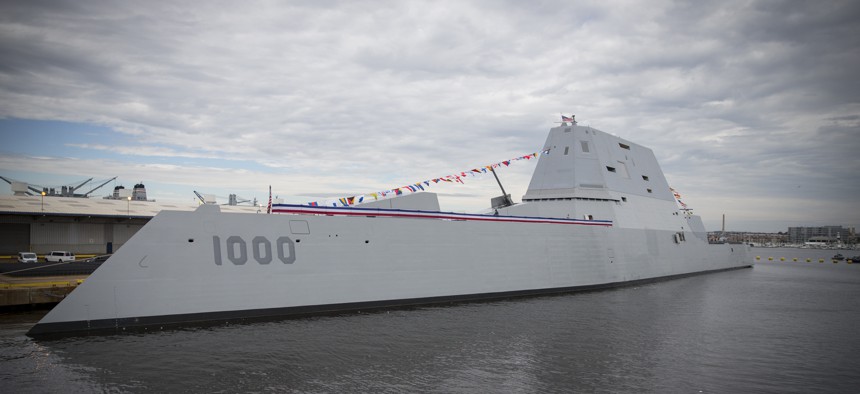
The future Zumwalt-class guided-missile destroyer USS Zumwalt (DDG 1000) is pierside at Canton Port Services in preparation for its upcoming commissioning on Oct. 15, 2016. U.S. Navy photo by Petty Officer 2nd Class George M. Bell
Should Sailors Be Able to Reprogram Their Ship?
The U.S. Navy’s newest destroyer is automated to an unprecedented degree. Should the crew be allowed to harness it with code?
BALTIMORE, Md. — Algorithms and automation are baked into the U.S. Navy’s newest warship. Commissioned on Saturday, the 12,500-ton USS Zumwalt is rigged with enough sensors and servomotors to run with just half the crew of a regular destroyer.
The Zumwalt’s skipper described his sailors’ efforts to write the operating manuals for their first-in-class vessel. They discovered, for example, that starting a certain motor required pushing a certain button for a certain number of seconds.
That bothered me. Shouldn’t a ship so advanced have an interface without tricky timings? Or shouldn’t its sailors be able to fix it with a bit of custom programming? Or even...shouldn’t sailors have a way to write scripts to make it easier and faster to run their big floating computer of a warship?
Broadly speaking, scripts are short programs in high-level languages, often used to automate workflows. Photographers write them to process digital images in batches. Number-crunchers deploy them in Excel spreadsheets. Editors use them to clean up text for posting online.
So I asked the skipper about this. Capt. James Kirk (yep) is no stick in the mud – he flashed the Vulcan salute to reporters who asked about his connections to Star Trek. But Kirk visibly blanched at the prospect of messing with the extraordinarily complex code that runs his ship.
“I mean, we don’t generally change software underway,” he said. “We want to make sure we know what the configuration is, that it’s tested, and we validate it works correctly. So this isn’t a situation where we’re modifying that on the fly.”
Read more Inside the Secret Interior of the Navy’s First Stealth Destroyer
See also Is This the Warship of the Future?
It's not that changes are bad per se; modern warships are built to accept software upgrades smoothly and quickly. (Earlier this year, the attack submarine New Mexico spent a night by a Rhode Island pier, getting updates to its ship-control programming.) But installation is one thing; writing and debugging is another.
Old hands will remember the USS Yorktown, the Navy’s original Smart Ship, which went dead in the water in 1997 after someone caused a computer to divide by zero. And it’s easy enough to conjure visions of scripted weapons run amok.
Yet surely the digital natives who will soon be running the Navy’s computer-ships will have the urge to innovate and the technical chops to do it with code. It is at least envisionable that a truly sophisticated warship would allow for some onboard customization.
Military analyst Peter W. Singer, whose Ghost Fleet novel of near-future war stars the Zumwalt, sees both promise and peril in scriptable weapons.
“It’s an important issue that will have to be worked out,” Singer says. “Pushing out innovation sounds great, until it comes down to execution. You want that kind of flexibility to keep the systems updated and reactive, as well as tapping sailors’ insights, but you can empathize with the deep worries it presents of security and unintended foul-ups.”
Later, at the Pentagon, I asked Air Force Brig. Gen. Alexus Grynkewich about the idea. The test pilot-turned-deep thinker recently sifted through hundreds of proposals meant to help the Air Force gain air superiority over future battlefields. Grynkewich noted that some of the benefits of scriptable weapons could be realized if defense manufacturers could learn to be ultra-responsive to requested changes. He also noted that, eventually, artificially intelligent machines would learn to improve their own automation.
But in the nearer term, he said, the ability to write scripts for weapon systems “would be a huge force multiplier.”
“You’d have to do it with discipline, especially when you talk about airworthiness, and safety, and everything like that. But which is safer: having more capability or less? That’s part of the equation too,” Grynkewich said. And in the cyber domain, he said, “We absolutely are going to need our folks to do those sorts of innovative things. Not just use contractor-provided software solutions, but rejigger their applications so that they can do what they need to do, whether for offense or defense.”
Back on the Zumwalt, where automated fire fighting systems promise to route around damage and react more quickly and decisively than humans, the crew is nevertheless still training to do damage control the old-fashioned way.
"You don't want to put all your chips on the computer," said Sonar Technician First Class Brian Vergo.
But you might want to put a few on sailors’ innovation.
